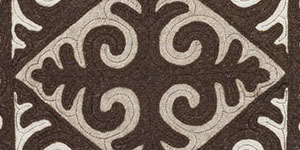
Bedding was one of the primary components of a bride’s dowry—young women both nomadic and settled, poor and wealthy were expected to bring these items to the marriage. Women from wealthy families produced kurak (patchwork) and whole cloth quilts of luxurious silks and satins demonstrating exquisite craftsmanship, almost a courtly art. Women, whether wealthy or not, often alternated patchwork blocks with embroidered ones, the design of which frequently echoed the pattern of the patchwork. Tajiks, in particular, believed the elaborate arrangement and numerous kurak seams would confuse and entangle negative spirits that would otherwise harm their family.
One special object was the suzani, an intricately embroidered and quilted textile from Uzbekistan and northern Tajikistan. Suzanis were used as covers and quilts for the bridal bed and brazier, as dividers between sleeping and living quarters, and as prayer rugs and wrapping cloths. Traditionally, a woman began the work of embroidery at the birth of a daughter and continued with the help of family and friends until the girl’s dowry was complete. The dowry of a bride from a well-off family in Nurata, Uzbekistan, was expected to include ten suzanis of different sizes and functions.
Another unique form of bedding upon which people sat and slept was felt shyrdak carpets. Constructed with an inlay technique, these rugs were made only by the Kyrgyz, Kazakhs, and semi-nomadic Uzbeks. The shyrdak master would simultaneously cut two pieces of felt in contrasting colors with a knife or scissors into a traditional pattern, and reassemble them with the positive of the first color set into the negative of the alternate color. She then joined the seams by hand, while at the same time covering them with fine, decorative hand spun threads. The practice of making shyrdak is being revived today, encouraged by various NGOs.